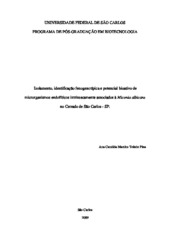Isolamento, identificação fenogenotípica e potencial bioativo de microrganismos endofíticos intrinsecamente associados à Miconia albicans no Cerrado de São Carlos - SP
Abstract
Endophytic microorganisms lives in symbiotic association with plants and in one unique biological niche, and they are potential producers of natural bioactive substances with different chemical structure and biological activity. This study aimed to isolate and characterize endophytic microorganisms from Miconia albicans from Cerrado of São Carlos - SP. Samples were characterized phenotypically from typical features of colony morphology and macroscopic measurements, physiological, biochemical and morphodyeing and genotypically by 16S rRNA analysis. We evaluated the antagonistic potential of the isolates against Staphylococcus aureus ATCC 25923, Escherichia coli ATCC 25922, Serratia marcensis IAL 1475, Enterococcus faecalis ATCC 29212, Shigella sonnei ATCC 10231 and Candida albicans ATCC 10231. Two samples (1 and 3) showed bioactivity against E. faecalis, with inhibition halos of 1.30 and 1.90 cm in diameter, respectively. A single sample (2) showed activity against S. marcensis (3.60 cm) with no significant bioactivity against the other microorganisms tested. In one sample (4) showed activity against four of the six microorganisms tested: E. faecalis (3,15 cm) , S. aureus (3,50 cm), C. albicans (3,35 cm) e S. sonnei (3,20 cm). In another sample (6) was detected bioactivity against E. faecalis and S. aureus, with inhibition zones of 1.80 and 1.50 cm, respectively. One of the samples (8) showed bioactivity against the greatest number of indicator microorganisms with inhibitory halos of 2.60 cm against E. faecalis, 1.50 cm against S. aureus, 2.40 cm against C. albicans, 2.10 cm against E. coli and 2.50 cm against S. sonnei. In two samples (5 and 7) there was no evidence the bioactive ability against indicator microorganisms tested. Phenotypic analysis of 8 endophytic microorganisms isolated allowed us to classify 50% of these (samples 4, 6, 7 and 8) in the Actinomyces group and the others were classified in the genus Streptomyces (samples 1, 2, 3 and 5). In the genotypic analysis of two isolates with bioactivity were identified as Nocardiopsis Dassonville (sample 3) and Amycolatopsis orientalis (sample 8), reporting for the first time his association with endophytic aerial parts of Miconia albicans from Cerrado of São Carlos, SP.
